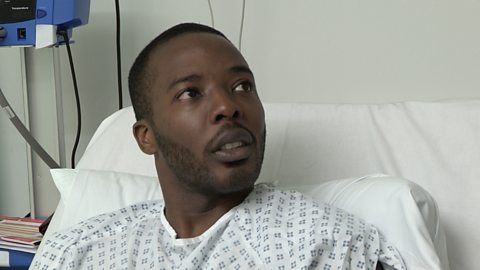Giving sensitive and clear information
Watch the video to find out more.
Speaker 1: We've come to the end of the test.
Speaker 2: Mm-hm.
Speaker 1: Here is your results.
Speaker 2: OK.
Speaker 1: As you can see from your blood pressure, which is higher than 140, so the ideal is between 90 and 120.
Speaker 2: Right.
Speaker 1: So, in this case, I would encourage you and refer you to see your GP.
Speaker 2: GP? Really?
Speaker 1: Just to double-check what might be the cause of it, and also to do another measurement, which might be different than from today.
Speaker 2: Hm.
Speaker 1: Other support I can offer you is our health trainer service.
Speaker 2: Health trainers? What do they do?
Speaker 1: In your case, they might support you looking on your high blood pressure, what it might be, what you might change.
I think I can arrange this for you today.
Speaker 2: Today?
Speaker 1: Yes. Would you be happy with that?
Speaker 2: Well, I'm here, so yeah. Why not?
Speaker 1: (TO AUDIENCE) Telling the client bad news, it can be difficult at times so I need to be very sensitive and also give him clear information that he understands.
Which techniques would you use?
Test your knowledge with this activity.
Passing on relevant information
Watch the video to find out more.
Speaker 1: Max, can I have a word?
Speaker 2: Hi, Lenke.
Speaker 1: Hi. I've just seen the client
Speaker 2: OK.
Speaker 1: who would like to be referred to you.
Speaker 2: Yeah.
Speaker 1: His name is John.
Speaker 2: Alright.
Speaker 1: And as you can see from his results, his weight is in normal range but his blood pressure is quite high.
Speaker 2: That's really high. So how's he feeling about that?
Speaker 1: Well, he is a bit anxious.
I've just told him, but also he's very happy to see you today.
Speaker 2: OK. I do have some time, but that will only be in the next 30 minutes.
So if he's willing to wait around, I'll see him then.
Speaker 1: That's great. I'll let him know.
Speaker 2: Alright.
Speaker 1: Thank you.
Choose the right information to pass on
Test your knowledge with this activity.
Asking the right questions
Watch the video to find out more.
Speaker 1: Hi, John. Nice to meet you. I'm Max.
Speaker 2: Hello.
Speaker 1: Please take a seat.
(SPEAKER 2 SIGHS)
Speaker 1: I've heard you've just been diagnosed with high blood pressure.
How does that make you feel?
Speaker 2: Well, I'm shocked. I'm under 50.
I don't expect to have high blood pressure.
Speaker 1: Yeah, absolutely. Is it OK if I ask you a few questions about your lifestyle?
Speaker 2: Yeah.
Speaker 1: Could you tell me how much water you're drinking on a daily basis?
Speaker 2: Water? No, no. I drink coffee.
Speaker 1: And can you talk me through an average day of your diet?
What did you have for breakfast yesterday?
Speaker 2: Breakfast, well, a biscuit for breakfast with a coffee.
Sandwich for lunch, I like a fry-up in the afternoon and then usually a kebab later in the evening.
Speaker 1: So you're eating quite late at night.
Could you tell me roughly what time you're having your last meal?
Speaker 2: I don't know. About 11?
Speaker 1: Are you eating any fruit and veg?
Speaker 2: Well, you know, you get tomato with a kebab.
Speaker 1: That's positive. At least you get one of your five a day.
(TO AUDIENCE) I ask a lot of questions and I take a lot of notes.
This helps the identify and clarify who the client is and this helps him in the long run as we get a clearer picture of who they are and where they want to be.
(TO OTHER PEOPLE) Did you know that eating lots of processed foods has high salt in it and that actually leads to high blood pressure?
Speaker 2: Not really.
Speaker 1: So, John, based on what you're telling me, it looks like we need to make some lifestyle changes.
Are you happy to do that with me?
Speaker 2: Well, it depends what it is but, yes, I suppose so.
Spot the right questions
Test your knowledge with this activity.
More on Health and social care
Find out more by working through a topic
- count4 of 5

- count5 of 5
